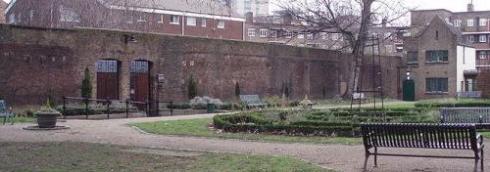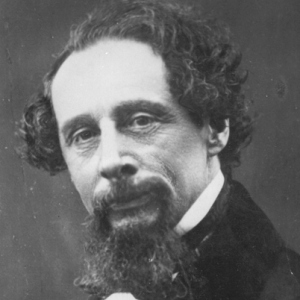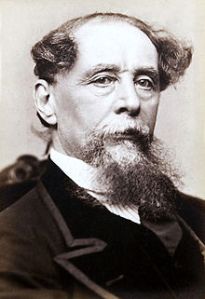Archive for the ‘Borough’ Category

Every time I pass through Borough I make a short visit to look at the crumbling remains wall of Marshalsea Prison. The once infamous prison no longer stands there, except for a single surviving wall, but it is forever immortalised in Charles Dickens’ novel, Little Dorrit.
Dickens wrote about Marshalsea from first-hand experience as his father was imprisoned here for a debt to a baker. As a result, Dickens was forced to leave school at the age of 12 and work in a ‘blacking warehouse’, where he earned a wage of 6 shillings a week, to help support his family.
Marshalsea was a debtors prison, which also housed sailors under sentence of court martial, and political figures accused of sedition. Dickens described the jail as “an oblong pile of barrack building, partitioned into squalid houses standing back to back; environed by a narrow paved yard, hemmed in by high walls spiked at top.”
Run privately for profit, the Marshalsea was run like an extortion racket. Debtors were segregated from the criminals, and they had to pay an admission fee for their accommodation at the prison, the quality of which depended on how much they could afford. For prisoners who could pay, there was access to a bar, shop and restaurant, and they were let out to work during the day. Everyone else was crammed into one of nine small rooms with dozens of others, possibly for decades for the most modest of debts.
Marshalsea was particularly unusual because the prisoners’ family and children were housed with them, which made it unbearably overcrowded. An investigation by a parliamentary committee in 1729 revealed a scandalous abuse of power involving torture, deliberate starvation and prisoners being suffocated to death, such were the cramped and inhumane conditions. The report revealed that 300 inmates had starved to death within a three-month period, and as many as ten prisoners were dying every 24 hours in the warmer weather.
The diary of John Baptist Grano, a musician imprisoned for debt, gives us an intimate glimpse of Marshalsea at this time and shows us the reality of two prisons existing in one establishment.
The ‘master’s side’ for those who could pay for their keep and the dreadful ‘common side’ where prisoners were deprived of all charitable assistance until they were helped by their friends or starved to death. Marshalsea is therefore a reminder of the injustice, oppression and rapacious profiteering that underpinned daily life in the eighteenth-century metropolis.

Marshalsea was closed by an Act of Parliament in 1842 and the lands sold off. This quote from Little Dorrit sums up many people’s attitude towards the prison: “Thirty years ago there stood, a few doors short of the church of Saint George, in the borough of Southwark, on the left-hand side of the way going southward, the Marshalsea Prison. It had stood there many years before, and it remained there some years afterwards; but it is gone now, and the world is none the worse without it.”
Just before writing Little Dorrit, Dickens decided to come here again to see what remained of the prison. He found that ‘the front courtyard, often mentioned in the story, had become a butter shop, and the former walls and the prison were now just part of the neighbourhood, but the grim old prison continued to have a powerful impact on Dickens throughout his life, and may even have contributed to the bouts of depression he experienced later in life.
Looking back on the dark days of 1824 when he visited his father in prison, Dickens wrote: “my whole nature was so penetrated with grief and humiliation…that even now, famous and happy, I often wander desolately back to that time of my life in my dreams.”

Opposite the prison site is the Church of St George the Martyr, a building which Dickens also visited regularly. The present church, believed to be the third on this site, was built in the 1730s and is commonly known as “the Little Dorrit church” after the character in the Dickens’ novel, who was born in Marshalsea and both christened and married at St George’s.
Dickens lived a short distance away in Lant Street, lodging in a house that belonged to the Vestry Clerk of St George’s. He set several scenes of the novel in and around the church and there is a small representation of Little Dorrit in the east window of the church.
Tim Russell

On a dark, cold October night in 1857, Charles Dickens stepped out of his home in Tavistock Square at two o’clock in the morning, and walked to his country house, Gad’s Hill Place, near Rochester, some 30 miles away.
His route took him through Holborn, across Blackfriars Bridge to Elephant and Castle, before heading down the Old Kent Road and off to Rochester.
He was 45-years-old and the walk marked something of a crisis in the great writer’s life. It was the year that Dickens met 18-year-old actress ‘Nelly’ Turnan, a girl who was to become his mistress. Unable to publicly leave his wife of 20 years, for fear of scandal, Dickens set Nelly up in a villa that he could secretly visit.
Dickens knew the streets of London like the back of his hand, from the highest courts to the lowest slums, and the walk to Gad’s Hill took him just seven hours. The reason why he set off on these
long nocturnal rambles was his inability to get to sleep during this period. In his essay, Night Walks, he wrote: “Some years ago, a temporary inability to sleep, caused me to walk about the streets all night. I would get up directly after lying down, go out, and come home tired at sunrise. My principal object to get through the night.”
Most of Dickens’ walks took him through the city and into south London. “If we were very lucky,” he said, “a policeman’s rattle sprang and a fray turned up; but, in general, surprisingly little of this diversion was provided. Except in the Haymarket, the worst kept part of London, and about Kent-street in the Borough, and along a portion of the line of the Old Kent-road, the peace was seldom violently broken.”
It is believed that Dickens’ inability to sleep was partly due to the turmoil in his mind – created by his affair with Nelly and the desire to divorce his wife Catherine – but some experts now believe it might also have been caused by manic depression, also known as bipolar disorder, which is characterised by cyclic shifts in moods between mania and depression, and it is likely that he found walking to be the best antidote to the condition’s debilitating effects.
By this time Dickens was the most famous author in the world. He was wealthy and seemed to have it all, but after a very difficult childhood, which saw the author working in a blacking factory and living on his own when his father was thrown in prison, Dickens started falling into depressions with the start of each new novel.
His friends wrote that he became down every time he set to work on a new project, but his mood would gradually lift until he was in a kind of mania by the time he finished. Dickens depression seemed to worsen with age, and he eventually separated from his wife to live with Nelly. After he was involved in a train crash four years before his death, in which he assisted dying passengers before help came, his depression seems to have finally blocked his creativity, and his previously prolific output virtually ceased.
Whether this view of his mental health is true or not, the great writer undoubtedly had an affinity for the people in Bethlehem Hospital. During his night walks he would often walk pass the hospital and wonder whether there was really such a big difference between the people called insane within the hospital’s walls and the public who were free to walk outside. In Night Walks, he writes: “Are not the sane and the insane equal at night as the sane lie a dreaming? Are not all of us outside this hospital, who dream, more or less in the condition of those inside it, every night of our lives? Are we not nightly persuaded that we associate with kings and queens, emperors and empresses? Do we not jumble events, people, times and places, as they do? One afflicted man said to me, “Sir, I can frequently fly. I was half ashamed to reflect that so could I by night.”
As dawn approached Dickens would often enter a railway station to watch the morning mail come in.
“The station lamps would burst out ablaze,” he said. “The porters would emerge, the cabs and trucks would rattle to their places, and, finally, the bell would strike up, and the train would come banging in, knowing that sunrise was not too far away.” It was only when he could see that daylight was gradually approaching that Dickens could relax and begin to feel tired and finally go home to sleep.
Tim Russell



